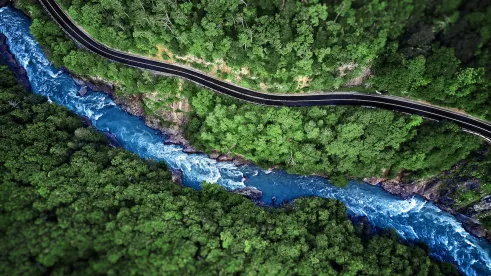The U.S. Environmental Protection Agency (EPA) published a final rule to interpret the requirements for water quality certification under section 401 of the Clean Water Act. This Section grants states and approved tribes the authority to review federal permits and licenses and add state requirements necessary to protect water quality. Section 401 gives states and tribes a great deal of direct, federal law authority, as it prohibits issuance of a federal permit or license without such certification (or waiver of certification). Section 401 is an example of the way in which cooperative federalism operates under the Clean Water Act, providing states and tribes with a robust role in protecting water quality even when the permits for a regulated project are issued by the federal government. The certification process applies most prominently to wetlands permits under Clean Water Act Section 404, which are issued by the Army Corps of Engineers, and to the Federal Energy Regulatory Commission (FERC) licenses for pipeline and hydropower facilities
EPA’s interpretation of Section 401, as reflected in the new rule, likely would not directly bind the actions of states, tribes, or other federal agencies. EPA hopes to influence state and tribal action by this rulemaking and Executive Order 13868, titled Promoting Energy Infrastructure and Economic Growth, which directs other federal agencies to develop rules consistent with EPA’s. The new rule directly applies to EPA where it has Section 401 certification authority for Section 402 NPDES permits. The statutory requirements of Section 401 remain unchanged by EPA’s rule, as does the authority of the states and tribes to set requirements consistent with the Clean Water Act.
Section 401 certification has generated a great deal of controversy around high profile infrastructure projects, at times pitting an upstream state against its downstream neighbor. Because certification is required prior to obtaining a federal permit, certification delay results in project delay. While many states and other advocates promote the tool as critical for achieving important water quality protections, other states, as well as many project developers, are frustrated at the expansive use of certification to delay or block new infrastructure projects based on state law essentially unrelated to the protection of water quality. Those frustrated by historic Section 401 practices will welcome the new rule encouraging narrower and more timely certification review processes.
Requirements in the New Rule
The new rule addresses two issues critical to the certification controversy: the timeframe in which a state or tribe must act, and the scope of the requirements a state or tribe can impose. First, with respect to timing, the Clean Water Act generally requires certification within one year, but also states that certification be provided “within a reasonable time.” EPA’s new rule clarifies EPA’s view that states and tribes should only take the amount of time “reasonable” for a specific certification request and that failure to act within one year on any certification request will result in a waiver. The rule discusses EPA’s view as to when the one year starts to run, which is on the date of submittal of the certification request. Under EPA’s new interpretation, once certification is waived, the associated federal permit can be issued without any additional state or tribal requirements.
Second, EPA’s new rule seeks to narrow the scope of certification. Specifically, EPA has determined that Section 401 certification requirements designed to protect water quality must apply only to point source discharges associated with the permit or license. In EPA’s view, states and tribes should not use the certification process to impose requirements that will have a general impact on water resources, fish and wildlife, recreation, critical habitats, wetlands, and other natural resources, even if such requirements will improve water quality. Whether a state or tribal certifying agency agrees to follow EPA’s guidance will vary depending on the agency. Ultimately, whether or not a certification requirement is outside the scope of the CWA may be determined by courts.
EPA’s new approach to Section 401 certification signals less automatic deference by the Agency to states and tribes than in the past. Historically, EPA allowed some delay in certifications, as there was no bright line rule on when the evaluation period began. EPA has also historically interpreted Section 401 to allow broad requirements in state/tribal certifications that reflected, in certain instances, requirements not directly related to water quality, such as air quality or transportation issues.
Impacts on Project Development
EPA finalized the new rule with the stated purpose of improving the predictability and timeliness of Section 401 certifications. The rule as written is likely to increase the speed of Section 401 decisions with strict construction of the one-year time clock and when it begins. This change was already underway in light of case law that clarified Section 401’s restrictions on a state’s ability to cease and restart the one-year clock by agreement with the would-be permittee. See Hoopa Valley Tribe v. FERC, 913 F.3d 1099 (D.C. Cir. 2019). One unintended consequence of this clarifying of time for states and tribes to process a Section 401 certification request may be more denials if states/tribes conclude that the documentation provided in the time available is insufficient to support a certification.
Perhaps more significantly, if states follow EPA’s guidance, the rule can be expected to narrow the scope and types of requirements states impose under Section 401 certifications, or spawn more disputes about such issues. This rule is likely to significantly modify current practices and, like most of EPA’s more substantial rules, expect this one to be litigated. Some states have already made their opposition known, while industry and other regulated entities are pleased to see these new and, from this perspective, appropriate changes. In the absence of a nationwide challenge resulting in a single ruling on the validity of EPA’s new rule, the scope of state and tribal authority under Section 401 may evolve in individual challenges in multiple courts over time.
The new rule will not eliminate non-federal requirements imposed on a project via the certification process. States and tribes will continue to have significant interests in infrastructure projects located in their jurisdictions. The new rule does not alter their ability to deny or robustly condition Section 401 certifications with lawful if burdensome conditions designed to protect water quality.







 />i
/>i

